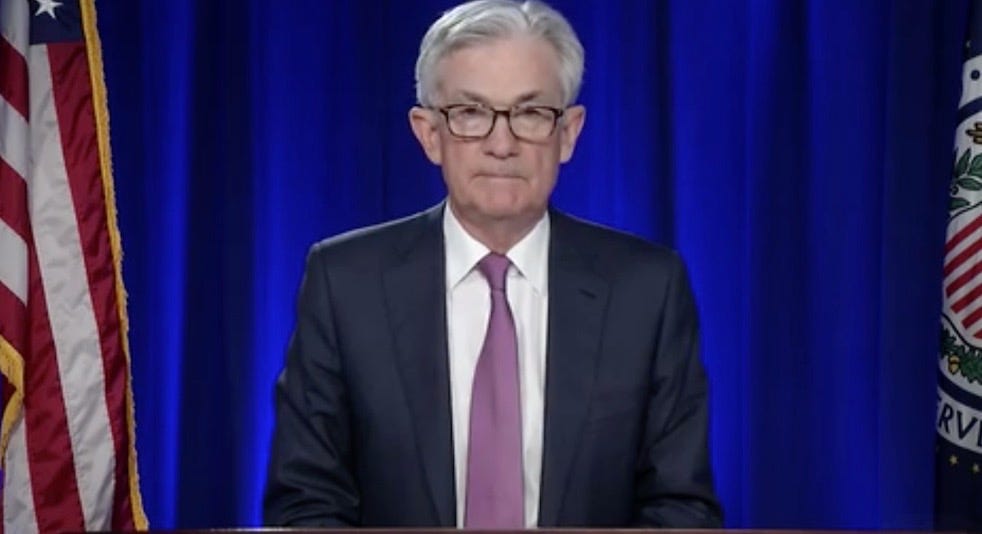Fed Minutes Show Need to Move 'Expeditiously' to Tame Inflation
Fed minutes came in more hawkish than traders expected
No-Risk Offer! Get the first THREE MONTHS FREE when you sign up for the annual Trends Journal subscription, with a 30-day money-back guarantee. Please enter the promo code Substack at checkout.
The doves at Fed Head Jay Powell’s Federal Reserve took a more hawkish approach to reining in inflation at this month’s meeting and most Banksters agree that the central bank may have to continue to raise interest rates a few more times - even if it meant weakening the economy in the process.
The Fed minutes from the May meeting were released at about 2 p.m. on Wednesday. The meeting occurred from May 3 to 4 and resulted in the central bank’s most significant hike in 20 years. The Fed also announced plans to reduce its $9 trillion balance sheet, which skyrocketed during the COVID-19 outbreak.
“Most participants judged that 50-basis-point increases in the target range would likely be appropriate at the next couple of meetings,” according to the minutes, which were viewed by The Trends Journal. Inflation hit 8.5 percent in April, which was its fastest pace in more than 40 years.
Those at the meeting saw some bright spots in the economy and said the U.S. was very strong and the labor market was extremely tight,. But “inflation was very high and well above the Committee’s 2 percent inflation objective.”
Bill Ackman, the hedge fund billionaire, told CNBC Tuesday that inflation in the U.S. will stay at historic levels until the Fed acts more aggressively when it comes to interest rates or “the stock market crashes, catalyzing an economic collapse and demand destruction.
“If the Fed doesn’t do its job, the market will do the Fed’s job, and that is what is happening now,” Ackman said. “The only way to stop today’s raging inflation is with aggressive monetary tightening or with a collapse in the economy.”
The central bank has boosted its base rate by three-quarters of a point so far this year. Analysts expect it to add another point by the end of July and keep raising the rate at least until 2023.
Markets are pricing in a year-end Fed rate of 2.7 to 3 percent.
The tiny “monetary tightening” the Fed has already imposed is hitting the housing market. The U.S. Census Bureau reported sales of newly built homes plunged 16.6 percent in April from March. The decline from April 2021 is even more dramatic at 26.9 percent. There were 591,000 units sold during the time frame, which is far short of the 750,000 that was expected. The median price of a new home was also up 20 percent from last year.
Powell said earlier this month that it would have probably been better for his department to have raised rates a little sooner.
SPECIAL OFFER: GET THE TRENDS JOURNAL MAGAZINE FOR $2 AN ISSUE
“I’m not sure how much difference it would have made but we had to make decisions on what we knew then and we did the best we could,” he said.
The Fed’s plan is to “expeditiously” raise interest rates to so-called neutral, a level at which inflation eases, the jobs market remains strong, and the economy does not stumble.
FOLLOW GERALD CELENTE ON TIKTOK
“Getting inflation down to 2 percent will include some pain but, ultimately, the most painful thing would be if inflation were to get entrenched in the economy at high levels,” he said.
TRENDPOST: Powell’s comment that “we had to make decisions on what we knew then” is hard to understand.
If 2 percent was a target rate, why did the Fed do nothing until inflation was rampaging at almost four times the “target” rate?
Inflation was raging throughout 2021, as we noted in “Inflation Tsunami Approaching” (4 May 2021), “Inflation Soon To Get Much Worse” (18 May 2021), “Fed Officials Send Mixed Signals on Policy Shift” (29 Jun 2021), “When Will Fed End Cheap Money Policy?” (27 Jul 2021), and in many of our “Market Overview” sections.
It took Powell until late November to stop saying it was “temporary” or “transitory.”
Throughout those months, the Fed worried too much about shoring up the jobs market and paid too little attention not only to inflation, but to the combination of global factors that were squeezing it.
CHINA AND RUSSIA GIVE THE WORLD A GLIMPSE OF WHAT WWIII COULD LOOK LIKE
At his December 2020 press conference, Powell pointed to “disinflationary pressures around the globe” and said “it’s not going to be easy to have inflation move up.”
A month later, with inflation on the move well above the Fed’s 2-percent target rate, Powell said it was only “temporary.”
In July, with inflation running at 5 percent, Powell told a Congressional committee that “we really do believe that these things will come down of their own accord as the economy reopens,” he noted.
Wrong, wrong, and wrong.
As we noted in “Fed: Stronger Economy, Steady Rates” (23 Mar 2021), Fed officials predicted overall U.S. inflation this year would be 2.4 percent.
Instead, it topped 6 percent in October and has averaged 4.1 percent from January through October.
Until November, Powell and the Fed’s Open Market Committee were referring to inflation as “temporary,” which became “transitory,” a more useful weasel word as what Powell had called “temporary” stretched into its 10th month.
In Congressional testimony last 30 November, Powell admitted it is “probably a good time to retire” the Fed’s characterization of inflation as transitory.
However, Powell himself did not retire; president Joe Biden reappointed him to another term as Fed Head and the U.S. Senate confirmed him by an overwhelming vote.
ICYMI




The sinews of war are infinite money.
-Marcus Tullius Cicero